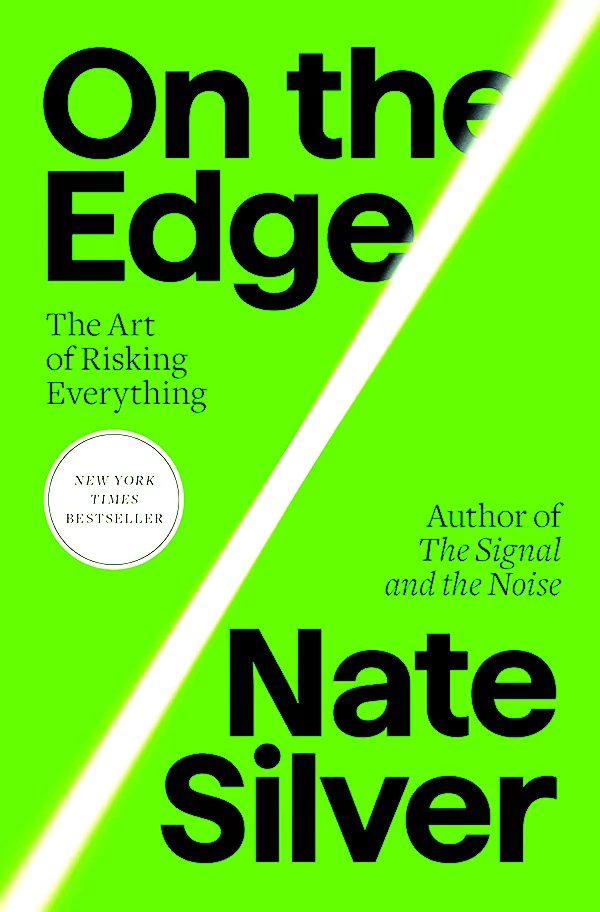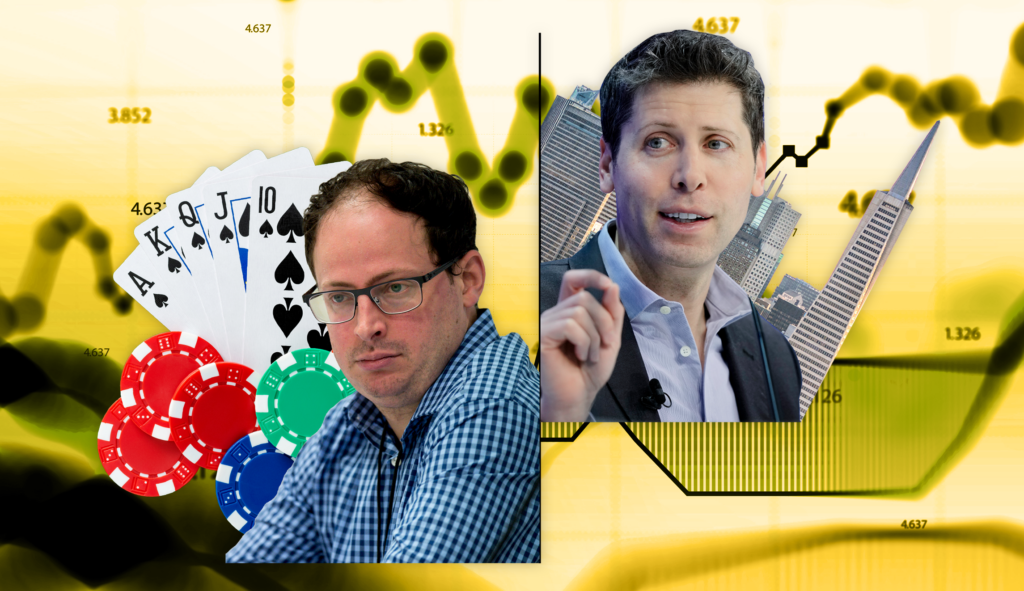Several years after being drummed out of polite progressive society because of his accurate political predictions, the statistician, pundit, and poker player Nate Silver is riding high.

Silver’s hugely popular Substack and highly precise (and proprietary) election forecasting model have vaunted him to the pinnacle of public figurehood. And while his departure from mainstream media wasn’t entirely voluntary, his triumph as an independent analyst vindicates the calculated career risks he has consistently taken.
In On the Edge, his new book about successful risk-takers, Silver applies his life lessons to politics and economics, beginning with the dichotomy he articulates between the River and the Village.
Silver describes the River as “a sprawling ecosystem of like-minded people that includes everyone from low-stakes poker pros just trying to grind out a living to crypto kings and venture-capital billionaires.” From a cognitive standpoint, Silver characterizes Riverians, who cluster in Silicon Valley, Wall Street, and casino floors, as analytical, abstract, and decoupling — playing devil’s advocate or holding two contradictory thoughts at once. Personality-wise, Silver’s River residents are competitive, critical, contrarian, and risk-tolerant.
Villagers, by contrast, inhabit Washington, D.C., and the halls of academia. They moralize and politicize their decisions. They’re risk-averse conformists, paternalistic partisans who succumb to confirmation bias. And while Silver steelmans both paradigms, his general framing reveals where his allegiances lie.
Expected value, or the average return on an investment, plays a central role in the worldview of the River. Never fearful of generalizations, Silver contends that “when it comes to financial and career decisions, people do not undertake enough risk.” Calculated gambles that produce positive expected value, or +EV, determine the course of politics and economics.
Take, for instance, Silver’s by-now-infamous 2016 election eve forecast that former Secretary of State Hillary Clinton had a 71% chance of winning. Data-illiterate observers, including many of Silver’s most vicious liberal detractors, misunderstood this prediction as the equivalent of Clinton leading Trump in the polls by a whopping 42-point margin. But in fact, Riverians prospered using this +EV prediction: Betting markets put Trump’s chances at a mere 17%, so anyone who, relying on Silver, wagered on Trump earned a tidy 74% return on their investment. For this reason, Silver writes, “Expected value is such a foundational concept in the River’s way of thinking that 2016 served as a litmus test for who in my life was a member of the tribe and who wasn’t.”

Silver begins his tour de force along the scenic route: a lengthy exposition of poker concepts, World Series personalities, legendary hands, and gambling trends that sets the stage for much of his discussion about risk. His explanation of basic poker concepts provides the vocabulary for the second, more interesting half of the book. He explores the ballooning realm of sports gambling, in which neither most bettors nor most companies actually succeed much, and the depressing world of slots, in which only the house wins. In every case, the advantage that even so-called “sharps” enjoy is evanescent and vanishingly thin: A “cardinal truth” of the River is that “the biggest edges never last for long.”
He also profiles five “highly successful risk takers” across a variety of professions ranging from astronauts to athletes to scientists. While many of their habits are unsurprising — they’re brave and calm under pressure, well-prepared, contrarian, and detail-oriented — others are illuminating. These risk-takers exhibit “strategic empathy,” meaning they’re successfully able to view the world from their adversaries’ standpoints. They focus on process, not results, and they’re skilled estimators. They’re also not driven by money as much as by a searing competitive fire.
What better place to encounter such risk-takers than Silicon Valley, the engine of global technological development? It’s there that Silver solicits input from the likes of serial entrepreneur Peter Thiel and arch-venture capitalist Michael Moritz and concludes that a long investment time horizon and asymmetric upside odds characterize the most successful Valley denizens. And it’s there that the divide between River and Village can most readily be discerned, whether over regulation, individualism, expertise, or wokeness. But while Silver is naturally more inclined toward the Riverian viewpoint, he frets that Silicon Valley has become overly reliant on “crazy a**hole founders” (“I think they’re highly skilled degenerate gamblers who got lucky”), embraces groupthink more than commonly believed, and disfavors women and minorities. Venture capital, he fears, “is becoming more and more like the incumbent institutions that Silicon Valley would deign to disrupt.”
Sam Bankman-Fried also gets the Silver treatment. The author tracks down the disgraced wunderkind in the Bahamas, before his fraud conviction, and argues that Bankman-Fried “wasn’t just a citizen of the River; he might have been the president of it.” Yet even after interviewing the enigmatic founder of the FTX cryptocurrency exchange, who vacillates between “Talking Shop Sam,” “No-S***s-Left-to-Give Sam,” and “Sneaky Sam,” Silver remains just as baffled as anyone, concluding that Bankman-Fried fell prey to “impulsive overconfidence” — the ultimate negative EV play.
Silver also critically examines the “effective altruism,” or EA, movement, which Bankman-Fried generously funded. This group of philosophers and activists, sometimes overlapping with the “rationalist” school (Silver provides a handy decoder chart), espouses a utilitarian approach to issues of morality and had gained purchase in the Bay Area in particular, before becoming tainted by its Bankman-Fried association. Calling the movement, at times, “the most important part” of the River, Silver methodically disassembles its risk-adjusted predictions of existential doom, whether from rogue AI, climate change, or a nuclear exchange.
By contrast, “at the very moment in late 2022 that Sam Bankman-Fried’s empire was collapsing, Sam Altman’s was soaring to new heights.” To Silver, Altman, who helms OpenAI and has taken potshots at Bankman-Fried and EA, embodies the best traits of the River. He even likens the large language models Altman developed to skilled poker players: They’ve climbed a steep learning curve, mastered the rules of the game, and deployed +EV concepts to maximize the quality of their linguistic output.
Along the way, Silver hangs with crypto bros at Art Basel Miami, observes the action in the glass-enclosed poker room at the Bellagio, and revisits game theory and the trolley problem. On the Edge, at times, reads like multiple books stuffed into one giant one. Many of its subparts deserve even fuller treatment of their own, and Silver acknowledges that certain sections were hacked down for space purposes. But the thread of risk, embracing it, managing it, exploiting it, ties the narrative together in an effective manner. He concludes by noting that while “the Village and the River are growing farther apart,” we can all benefit from embracing the value of agency, plurality, and reciprocity. It sure seems to have worked for Silver, so why not the rest of us?
CLICK HERE TO READ MORE FROM THE WASHINGTON EXAMINER
Michael M. Rosen is an attorney and writer in Israel and a nonresident senior fellow at the American Enterprise Institute.
